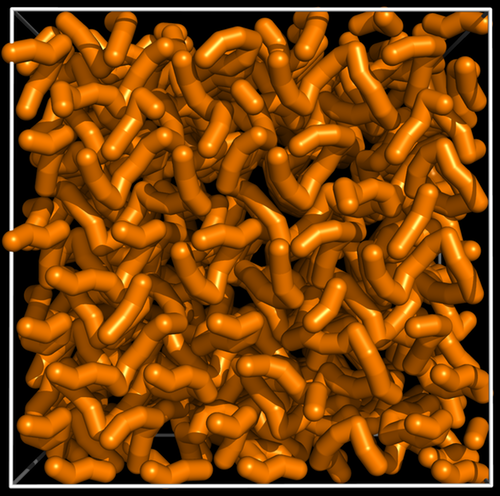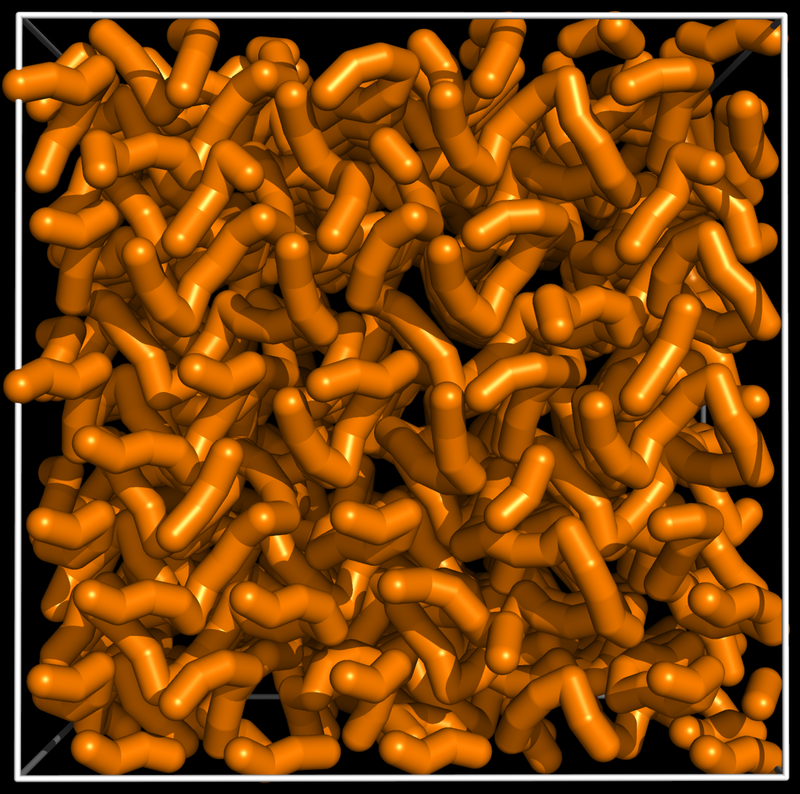It’s the Heat and the Humidity—Two Ways a Crystal Shrinks
Most materials swell when absorbing water, but some shrink, exhibiting “negative hydration expansion” (NHE). Experiments with one such substance, zirconium tungstate (ZrW2O8), now show how this unusual behavior comes about and how it is related to another, equally rare property: shrinkage on heating (negative thermal expansion, or NTE). At the atomic scale, hydration creates a dense, “tangled spaghetti” structure that is echoed in the heat response. Similar materials could someday be used to counteract heat- or humidity-induced expansion of components used in buildings.
NHE and NTE materials are potentially useful because they might provide a way to avoid unwanted variations in the volume of a component or structure when the temperature or humidity changes. For example, stresses caused by swelling of building materials under moist conditions can undermine the stability of architectural structures. But materials that shrink might compensate for such expansion, if they were part of a composite.
The atoms in a zirconium tungstate crystal have many modes of vibration that can move atoms into empty spaces and reduce the structure’s overall volume, says Andrew Goodwin of the University of Oxford in the UK. As the material is heated, more of these vibrational modes become active, he says. “But what has been missing is a clear understanding of why zirconium tungstate supports so many volume-reducing vibrational modes. What aspects of its structure make it so special?” Likewise, he says, it’s been difficult to explain the material’s NHE because the hydrated form is very disordered and thus hard to study in atomic detail.
Goodwin and his co-workers have now cracked the problem by combining x-ray scattering measurements of the hydrated and dehydrated material with calculations that predict their atomic structures and vibrations. The x-ray data for the hydrated form can’t be decoded as easily as those of the more orderly dehydrated crystals. But the researchers fine-tuned their calculated structures to optimize the match with the experimental results.
They found that the hydrated, disorderly form contains long chains of alternating W and O atoms that form from the interlocking of polyhedral tungstate groups such as WO5 and WO6. In the dry state, each tungstate group consists of a central tungsten atom surrounded by oxygens, and these groups link up via their oxygen atoms. This stringy structure forms because, when water molecules diffuse into cavities in the crystal structure, they bind to tungsten atoms and tilt the tungstate groups into positions that facilitate the linkages. There are three different possible orientations for each water molecule, and these orientations are adopted essentially at random. So the resulting structure contains a lot of disorder, which is why the team compares it to tangled spaghetti.
The spaghetti model agreed well with the previously uninterpretable x-ray data for the hydrated structure, Goodwin says. There was also good agreement with the researchers’ new x-ray scattering measurements, so they believe that the spaghetti structure explains the smaller volume of the hydrated state.
“These one-dimensional chains are novel, and, although the experimental structure determination looks quite challenging, their existence here is supported by the evidence,” says Neal Skipper of University College London, a specialist in inorganic materials that swell on hydration.
After explaining zirconium tungstate’s NHE, the team wondered if similar structural changes could be associated with the material’s NTE. According to their x-ray diffraction results and calculations, there is a similarity between the NTE vibrational modes and the structural shifts that occur when the material is hydrated and forms tungstate chains. “In the NHE mechanism, these bonds are actually formed, but in NTE we see only the structure fluctuating towards an increasingly bonded state,” Goodwin says.
These findings fit with existing, qualitative ideas about the relationship between hydrated structures and NTE behavior, says solid-state physicist Koshi Takenaka of Nagoya University in Japan. “This research is valuable because it clearly supports predictions vaguely envisaged by many researchers in the field,” he says. Goodwin adds that NTE materials should be good candidates in searches for NHE materials for structural engineering because they might undergo volume-reducing thermal distortions that can be reproduced and “cemented” by hydration.
This research is published in Physical Review Letters.
–Philip Ball
Philip Ball is a freelance science writer in London. His latest book is How Life Works (Picador, 2024).





